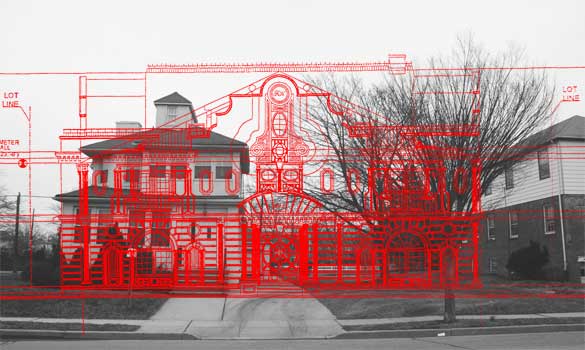92-Year-Old Manhattan Beach Rectory To Become McMansion

Community Board 15 voted overwhelmingly to approve a planned Manhattan Beach McMansion on the site of the rectory of St. Margaret Mary Catholic Church, despite objections from a local community group.
The request for a special permit to enlarge the current building by more than three times its current size and nearly double the size allowed by law came before the board during their Tuesday night meeting. The board voted 26 in favor and five against (with one abstention) to approve major modifications to the 92-year-old structure.
That approval came despite opposition from the Manhattan Beach Community Group, who said the lawyer’s claims about the building were based on faulty data.
“The measurements that they’re using for this house is flawed. The whole procedure is flawed. He shouldn’t be allowed to build that house,” said MBCG President Ira Zalcman.
Currently a 2,599 square foot home with 2.5 stories, the home at 215 Exeter Street was built in 1920 and served as the rectory to St. Margaret Mary Catholic Church. With a declining number of congregants, the parish merged with St. Mark Catholic Church on Ocean Avenue and Avenue Z several years ago. They decided to sell off the rectory portion at the end of 2010.
The land was purchased for $1.85 million by Mill Basin businessman Aleksandr Falikman, who began plotting a major overhaul of the property.
The new plans include more than tripling the square footage of the house to 7,848 square feet, nearly double the 4,000 square feet allowed by zoning law. It will also be nine feet higher at its highest point, but the perimeter walls will be reduced by one foot and four inches.
Though the new structure will come six feet closer to the sidewalk, most of the expansion will be done on the south side of the building, towards the water, and will reduce the space to the next house by nearly 40 feet.
“In order to make his point, the homeowner must show that other homes in his immediate area are larger than zoning allows,” Zalcman wrote in a letter to the board. “The homeowner before you this evening fails to make his point.”
As part of the approval process, homeowners seeking a special permit must show that the alterations would not violate the character of the neighborhood. To do that, they often show other houses in the area of similar size and character that were previously approved by the board.
Eric Palatnik, the attorney for the homeowner, offered as evidence another Exeter Street house on the other side of Oriental Boulevard, at 175 Exeter Street. The building was approved last year, and the homeowner was also represented by Palatnik.
According to the MBCG, though, the permit for 175 Exeter Street never should have been issued, as the evidence of similar sized structures (based on a Floor-Area-Ratio – or FAR – calculation) was based on faulty city data. The group cited an email a Department of City Planning official confirming that the data was inaccurate.
Zalcman blasted the idea of basing a current project on another project that itself was based on erroneous data from the Department of City Planning.
“City Planning has acknowledged errors in that data base known as PLUTO or Oasis. This evening’s application is, therefore, based on a home that was made larger where incorrect data was used,” Zalcman wrote. “We respectfully request that the Community Board inform the BSA that until the Department of City Planning corrects its data base(s), an informed decision cannot be rendered by Community Board 15.”
Zalcman and the MBCG are not alone in their opposition.
Of the five votes against approving the expansion, one came from Manhattan Beach Neighborhood Association President Alan Ditchek, who agreed that the building is out of line with the rest of the area.
“Knowing the house as it is now, a former rectory, knowing the other houses on the block, if it was enlarged it wouldn’t conform with the other houses as they appear,” Ditchek said. “I appreciate the landscape and the way things are right now and I think building that house bigger or expanding it would be out of character. ”
Zalcman said these kinds of approvals illustrate a systemic problem with zoning procedures that is destroying neighborhoods across this city.
“The zoning is being changed, without it being changed,” Zalcman said. “People are building bigger houses than are permitted without our zoning being changed. I’m sure it’s happening in other communities as well.”



